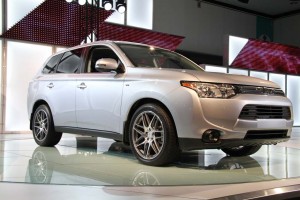
Mitsubishi announced it will close is manufacturing plant in Normal, Illinois, eliminating 900 jobs.
A day after the first reports surfaced on Japanese media, Mitsubishi Motors has confirmed it will shutter its aging and underutilized assembly plant in Normal, Illinois, a move that will cost more than 900 jobs.
That follows a failed effort to find effort to find a partner to share production at the facility that originally opened as part of a joint venture with Chrysler. But Mitsubishi officials stressed they plan to continue selling vehicles in the U.S. and point to a recent upturn in demand.
“Following a review of Mitsubishi Motor Corp.’s global supply chain, we have been informed it is necessary to end production and seek a strategic buyer for the Normal plant,” announced the maker’s U.S. subsidiary, Mitsubishi Motor Sales of America, in a prepared statement.
“Our focus right now is to identify a buyer who would continue to operate and maintain employment – the best potential outcome for our employees and the community,” MMSA added. “Today, we shared this news with our employees and our intent to work in partnership with the UAW and civic leaders over the coming months to achieve a successful result.”
The news takes few by surprise. At its peak, at the beginning of the new millennium, the Normal plant was turning out more than 200,000 vehicles annually. And Mitsubishi was one of the market’s fastest-growing brands. Then the bottom fell out.
A series of ill-conceived moves, including the launch of so-called NINJA loans, short for No Income, No Job or Assets, nearly drove Mitsubishi into bankruptcy, the carmaker saved only by a last-minute rescue by Japanese banks. Meanwhile, sales collapsed, and last year, the Normal plant produced just over 69,000 Mitsubishi Outlander SUVs.
Company insiders recently acknowledged, during a conversation with TheDetroitBureau.com, that the factory was losing millions of dollars annually.
The plant originally opened in 1988 under the name Diamond-Star Motors, a reference to the logos of Mitsubishi and what was then known as Chrysler Corp., the two having set the factory up as a joint venture. It was for many years the only unionized “transplant” assembly plant.
A senior official, asking not to be identified by name, lamented that Mitsubishi’s efforts to find a partner to share production in Normal were frustrated by the union’s presence. Potential partners they’d met with did not want to have a union workforce, the source noted, though another limiting factor was that the plant hadn’t been significantly updated in years.
Whether Mitsubishi will now be able to find a buyer for the sprawling facility, and whether that will be another car company, is far from certain. Also up in the air is whether a buyer would accept the continued presence of the UAW.
General Motors pulled out of a plant it operated with Toyota in a joint venture during the Detroit maker’s bankruptcy. The Japanese partner shuttered the facility soon afterwards. It was then taken over by electric vehicle maker Tesla Motors but the new workforce has not been unionized.
In all, as many as 918 hourly workers will be impacted by the closure of the Mitsubishi plant.
(Mitsubishi reported abandoning U.S. assembly plant. For more, Click Here.)
The decision has raised questions about Mitsubishi’s continued presence in the United States. But during a meeting with journalists last month MMSA EVP Don Swearingen said, “Some of you in this room may have written us off. But we’re here to stay.”
The maker reiterated that position in today’s formal announcement. “The North American market remains a priority for Mitsubishi Motors. We will continue to sell Mitsubishi cars, including current and planned models, at Mitsubishi dealerships across the United States,” it said.
(Click Here for a review of the 2016 Mitsubishi Outlander.)
On the positive side, after years of sharp declines, Mitsubishi’s U.S. sales for the first half of 2015 jumped 24.9% to 49,544.
“What’s clear is that Mitsubishi needs to introduce stronger products in the right segments of the market if they hope to recapture some of the success they saw years ago,” said Akshay Anand, an analyst with Kelley Blue Book.
(Mitsubishi may be here to stay, but in what form? Click Here for the story.)
A major update of the Outlander SUV recently came to market for the 2016 model-year, and the maker plans to add more new products between now and the end of the decade. But the roll-out was delayed by Mitsubishi financial problems and not everyone is convinced the maker will be able to get enough now product to market quickly enough to maintain its recent momentum.

B.S. It’s always the “unions” fault that a company can’t form a joint venture. Mitu’s U.S. sales have suffered in recent years and that has nothing to do with the unions. There will always be big companies looking to reap huge profits from underpaid labor. That is precisely why foreign auto makers build plants in the southern U.S., Mexico, etc. Exploitation of the workers so that the CEOs can reap millions in annual compensation is very common and outrageous.
The compensation of the “foreign” CEOs and management is no where near that of their U.S. counterparts. Nor did they have golden parachutes like their U.S. counterparts, which basically didn’t give the U.S. CEOs and management any incentive to do what was right. I mean, they were getting 100s of millions garaunteed whether the company succeeded or not, as long as they “made the numbers” for a couple years.